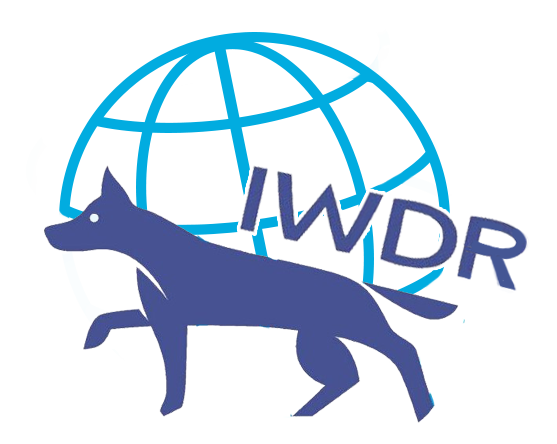Genetic diversity – managing inbreeding
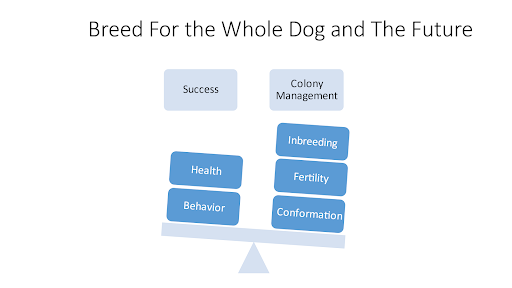
Inbreeding
Important issues for long-term management of a closed dog colony are
- Restricting the rate of increase of inbreeding
- Maintenance of genetic diversity
Inbreeding is the mating among individuals related to each other by ancestry.
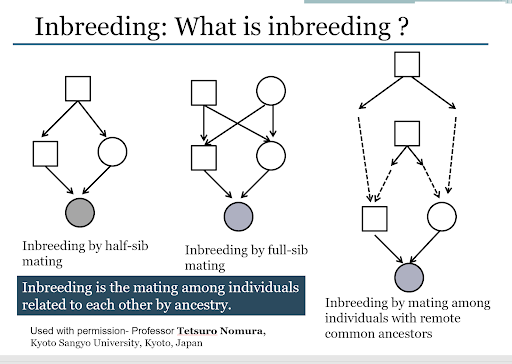
In 4 generations of ancestors, Rifleman has 1 dog listed twice. Keep in mind that additional dogs may be in the pedigree multiple times in more distant generations.

The inbreeding coefficient (F,COI) is the measure of the probability that two alleles at a given locus are identical by descent.
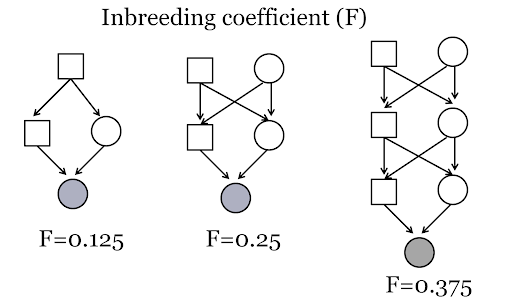
There are benefits and disadvantages to both homozygosity (alleles being alike) and heterozygosity (alleles not being alike).

The goal of guide dog breeders is to produce consistently good dogs; however, as genetic selection continues for many generations, the frequency of both desirable and undesirable (perhaps also unmeasurable) genes will increase.
A slow increase in the coefficient of inbreeding (F,COI) no greater than 2% per generation ALONG WITH selection using EBVs and the principles of selection is best. Rapid increases in the COI from overuse of popular studs or other inbreeding practices is very detrimental to the breeding colony.
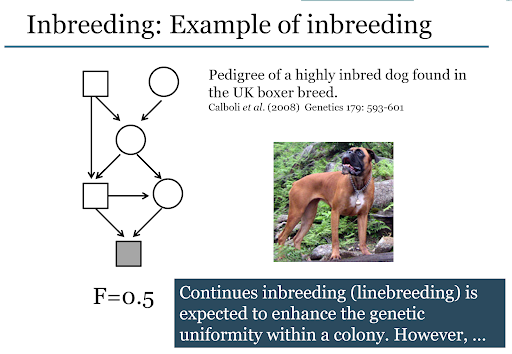
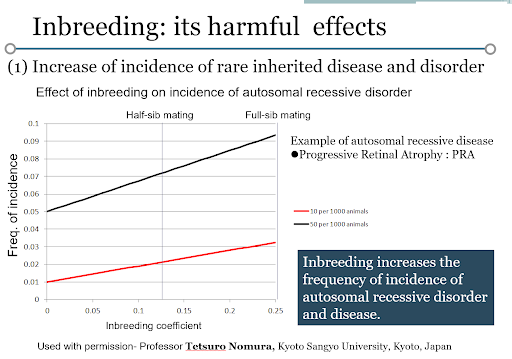
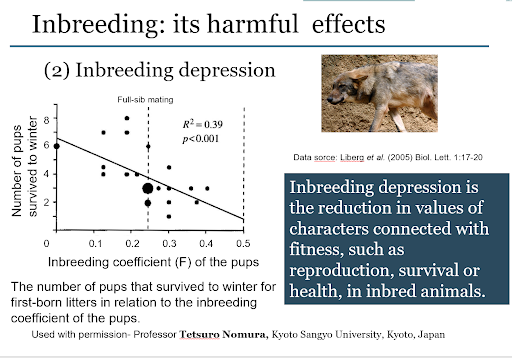
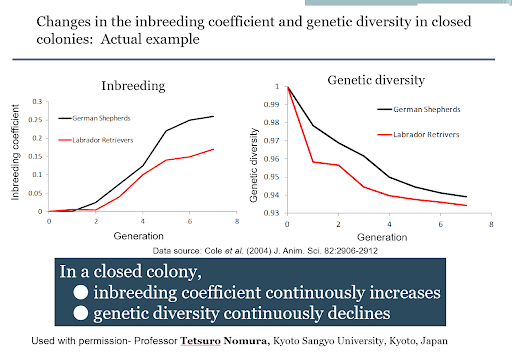
Genetic Diversity
Genetic diversity is the variety of alleles and genotypes present in the group under study (population, species or group of species)
The genetic diversity is the resource to realize required changes by artificial selection.
NOTE: The below presentation has been kindly approved for use of the IWDR by Professor Tetsuro Nomura from Kyoto Sangyo University and is not to be reproduced elsewhere. At the end of this section there are some comments that give some of the slides further context. We have provided the whole presentation for those that find it useful.


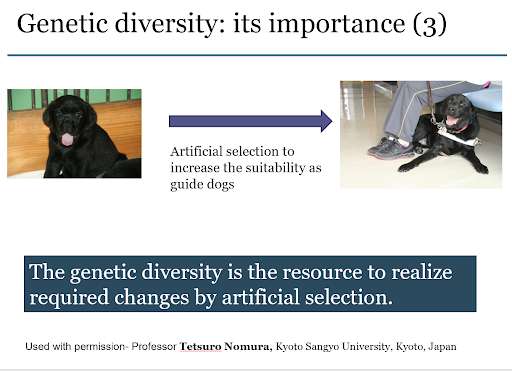

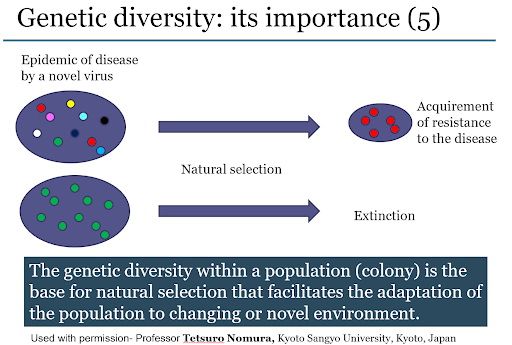
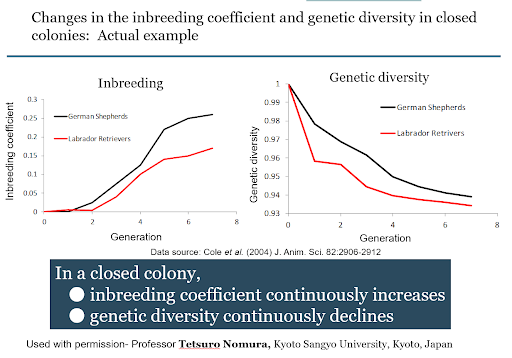
There are situations when high genetic variation can be a benefit; such as when the alleles are desired that are not present in the breeding colony. In this situation, new desirable alleles must be brought into the breeding pool without introducing too many undesirable alleles. Extensive phenotype genetic data on the dog of interest and its relatives will reduce the risk of introducing undesirable genes. However expect introduction of dogs from other colonies will introduce not only desirable traits but also undesirable traits.
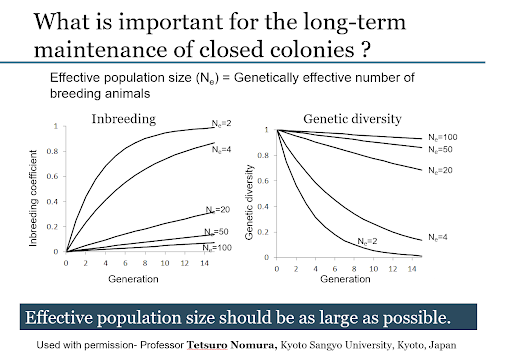
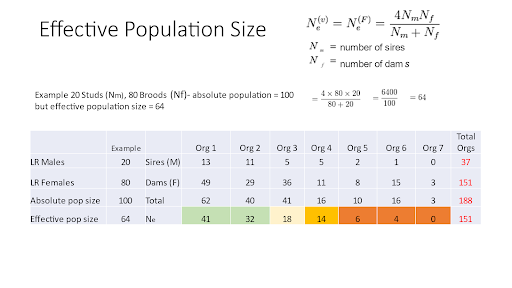
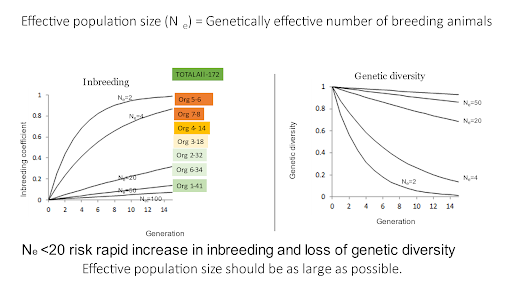
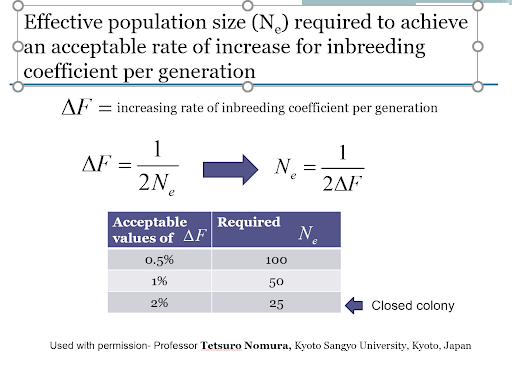
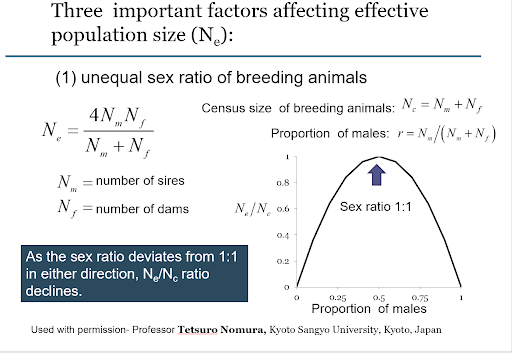
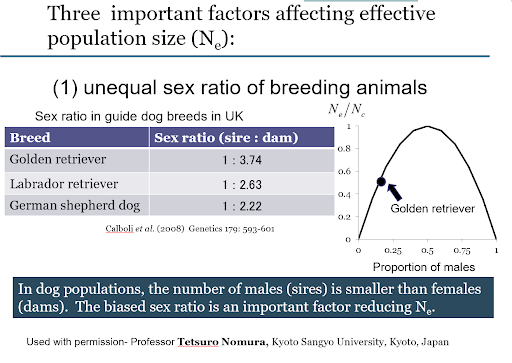
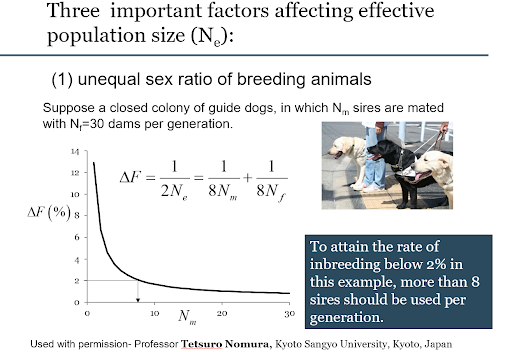
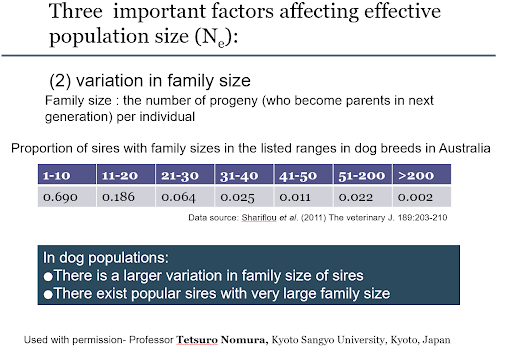
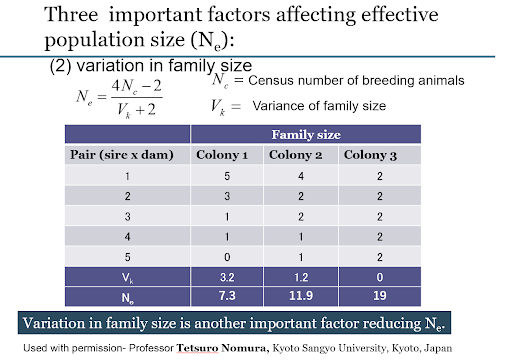
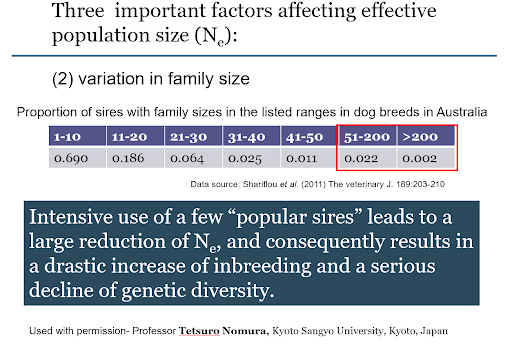
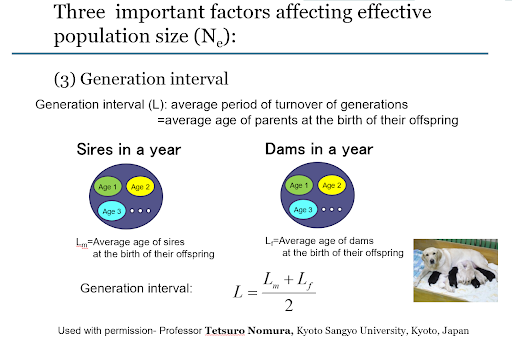
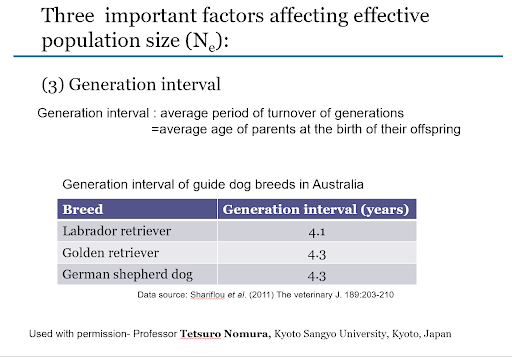
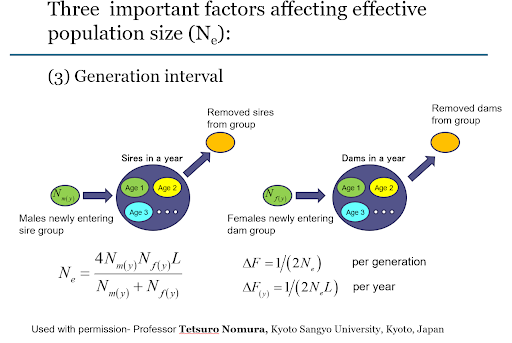
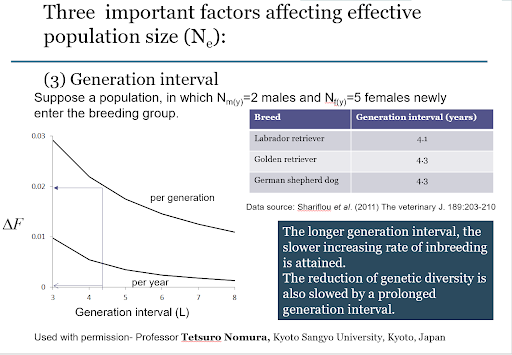
The COI calculation in both the calculation for individuals and also the test mating proposed progeny uses all of the pedigree information it has available. The COI will be inaccurate if the pedigrees are very shallow.
The number of generation classes in your population informs you how deep (complete) your extended pedigrees are. It will take awhile for the IBC organizations to fill out those ancestors so you have complete pedigrees. As noted above, the accuracy of the inbreeding coefficient depends on the completeness of the pedigrees. There is no hard and fast rule on the number of generations needed to have accurate inbreeding coefficients. If a few individuals are frequently represented in the pedigrees as is the case with a popular sire, it is more important to have the ancestors entered. On the other hand, if the ancestors are a mix of different dogs that are not closely related, adding more generations of ancestors will not have a big impact on the inbreeding coefficients.
We are working on providing some more tools within IWDR for managing the colony and a section in the IWDR website on diversity. The information below is from that section that is being written now.
Genetic diversity decreases as inbreeding increases.
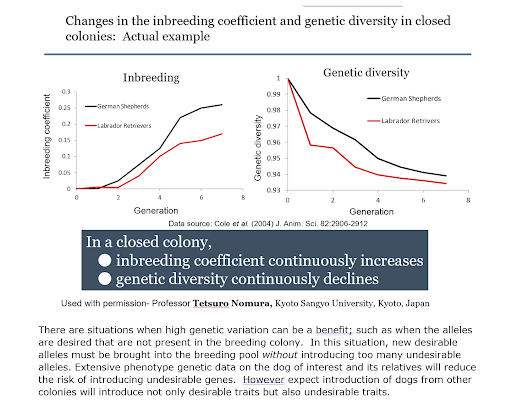
One of the measures we will be providing the calculation for is Effective Population Size. Individual small breeding programs typically have a small effective population size but through the use of the combined data in IWDR, EBVs are calculated on the population of IWDR dogs for each breed and ability to request sharing of data and germplasm enables collaboration where studs and progeny can be shared. If everyone is collecting high quality phenotypes on traits that matter and the phenotypes use the same scoring methods and the organizations breeding dogs follow the principles of genetic selection (see What is Genetic Selection?) then they can make tremendous genetic improvement while maintaining genetic diversity.
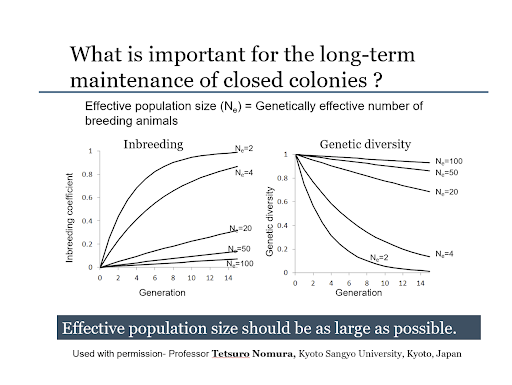
For your situation where you have many dogs out of one sire, you will definitely want to breed each of his progeny to mates that are as unrelated as possible. A mating between a male and female that are each 35% inbred, for example, will produce puppies that are 0% inbred, unless there are common ancestors in the pedigrees of the two parents. In fact, the best way to restore heterozygosity is to mate parents who themselves are highly inbred, but unrelated. In IWDR, the pedigree-based inbreeding coefficient of a prospective mating can be calculated before the mating is ever done, so it is easy to see what inbreeding level the pups will have.
There is a measure called effective population size which you can calculate. Do 2 counts:
- Count the number of different sires and the number of different dams that produced the pups in the past 24 months. 8 M, 10 F
- Count the number of different sires and the number of different dams that produced the active breeders = 9M, 9 F
Using those counts, you can calculate the effective population size yourself.
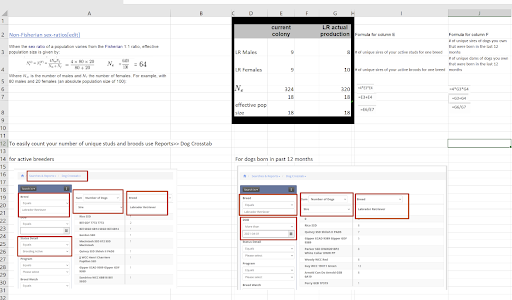
The number to pay attention to is the calculation on the active breeders but I like to tell schools to calculate it also with the actual number of breeders that are contributing to the next generation by counting unique sires and dams of the dogs born in the past year. If you are using your breeders equally, the 2 calculations should be close to each other, which it does in your case. Some schools hang on the breeders but don’t use them much or at all. This would be a misleading effective pop size calculation.
The goal is to have your Ne be as high as you can. You can see on the graph below that you are doing pretty well with genetic diversity if your Ne around 20 or more. Yours is 18 so you are doing well mostly because you are using a diverse group of breeders and avoiding mating the same ‘wonderful’ stud to many of your broods. I looked at a few pedigrees of your active breeders and Fletcher is an ancestor often on only one side of the pedigree and often 4- 5 generations back. This is not a cause for concern as long as your selection of replacement breeders is selecting the genetically best dogs for the traits you desire. As more EBVs are available (we are currently working on the return to productive state EBV from the BCL), you will have more tools to know that you are selecting the genetically best young replacement breeders. You will limit the rate of increase in inbreeding when choices are made to a suitable mate that produces the lowest inbreeding coefficient of the planned litter. By using the test mating COI calculator which uses all of the pedigree info available and knowing that the pedigrees are complete at least through 5 generations, you will be able to make these decisions in confidence.
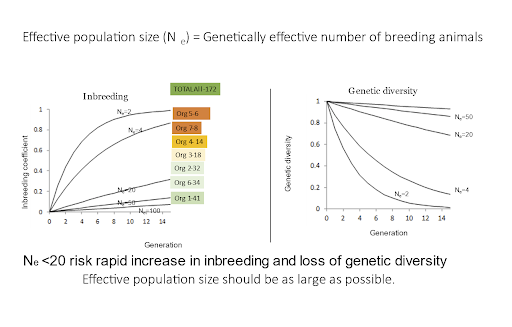
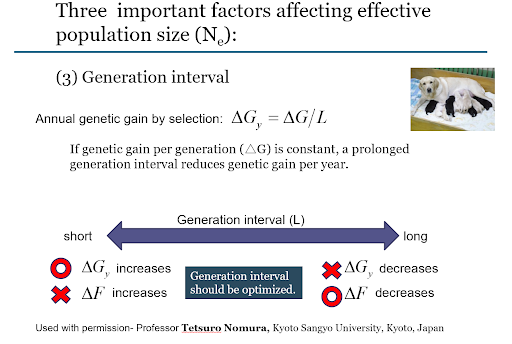
Suggestions for the long-term maintenance of guide dog colonies:
- In dog colonies, the number of sires is generally smaller than that of dams. However, an extremely small number of sires relative to dams should be avoided.
- Variation of family size among breeding animals should be minimized. Especially, intensive use of a limited number of sires and selection of breeders from limited families (litters) should be avoided.
- If the rate of inbreeding and the loss of genetic diversity are desired to be minimized, the generation interval should be managed to be as long as possible.
- However, when genetic improvement by artificial selection is also desired, an optimum generation interval should be found by balancing the two contradicting effects of generation interval on the genetic gain and the inbreeding rate.
